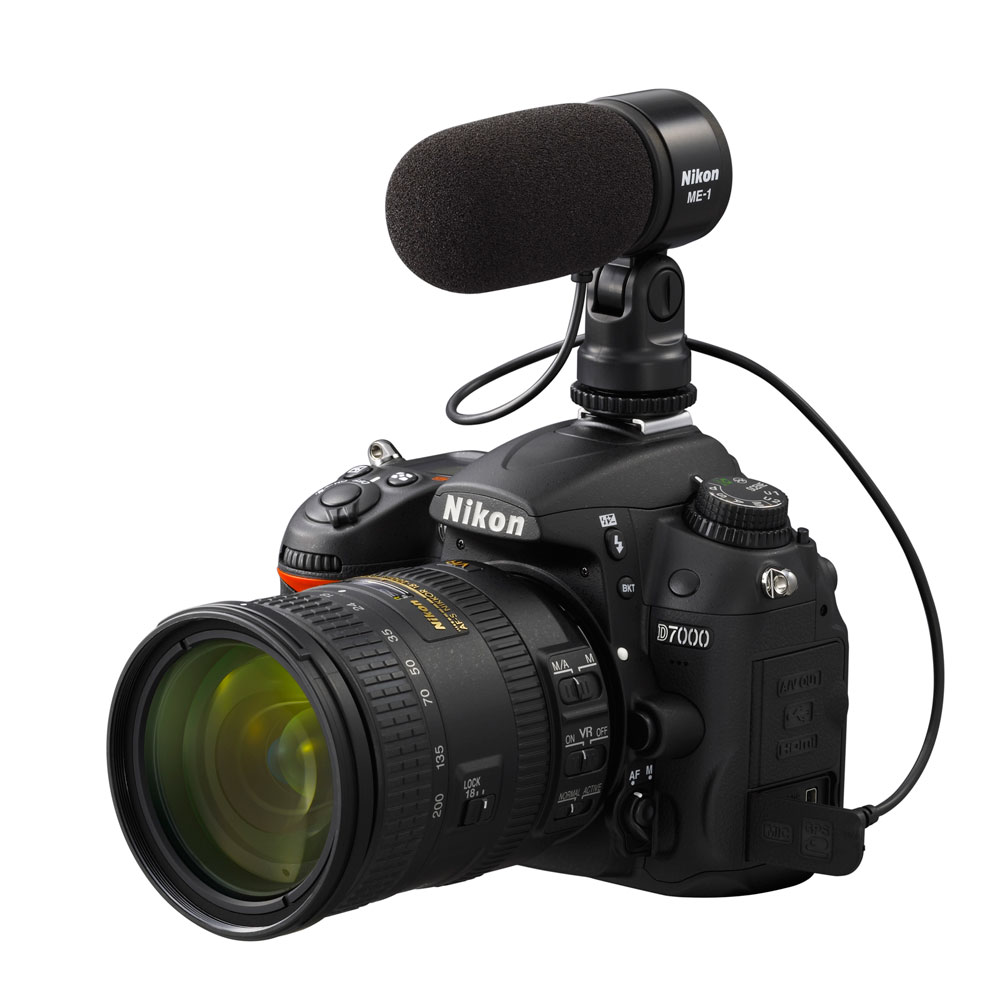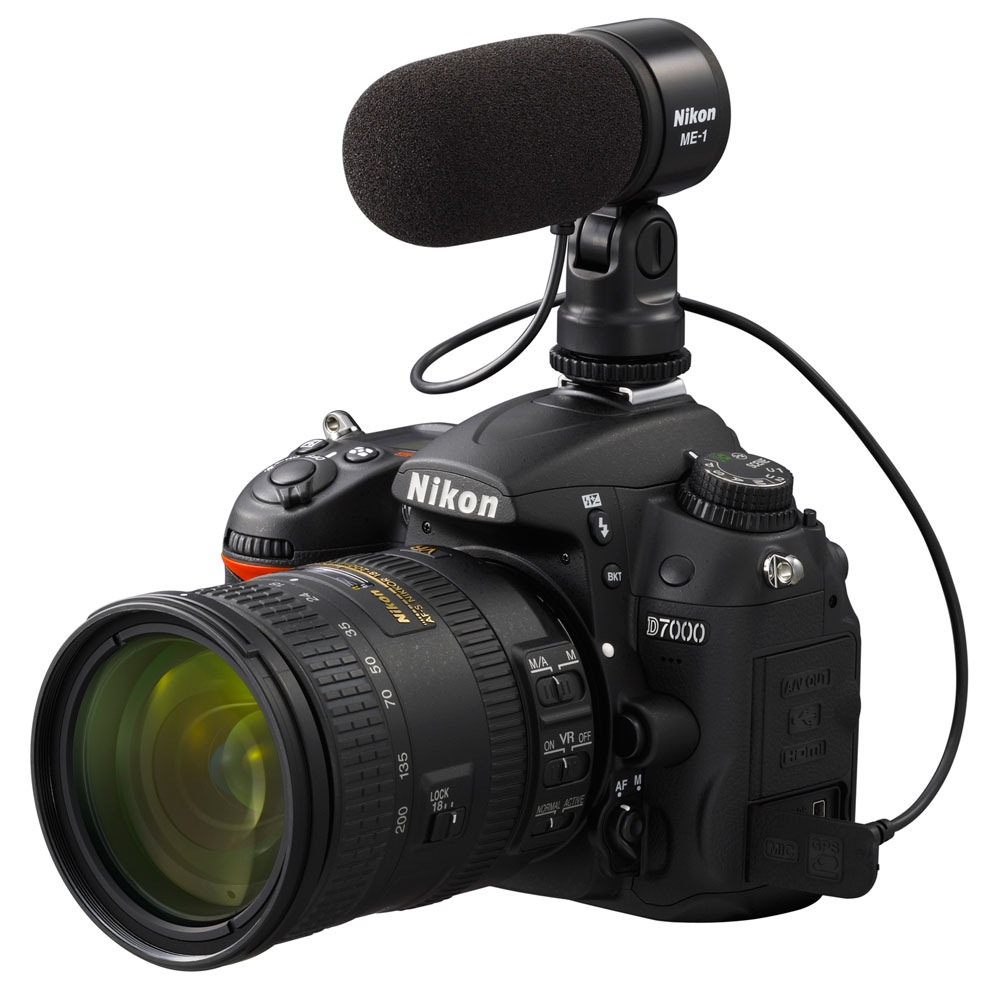The Importance of Quality Audio Capture
Using a few simple tips, you can increase the quality of the audio captured when shooting HD Video with your Nikon DSLR. High quality audio not only adds to the professional feel of your D-movie but to your viewer’s enjoyment as well.
The ME-1 accessory microphone is a stereo mic, which allows you to record audio in true stereo (two channels). The built-in mic in your D-SLR is monaural, also known as mono, which only captures sound in one channel. Stereo sound is closer to the way your ears hear sounds in real life, so it gives you a more natural effect. And, stereo sound is the ideal compliment to the high quality HD/ Full HD video that your Nikon DSLR is capable of recording.
The ME-1 is compact, lightweight and easy to use. In fact, you could keep it attached to the camera all the time (it slips onto your camera’s hot shoe); only taking it off when you want to take photos using either the camera’s built-in pop-up flash (if it has one) or an accessory Speedlight.
When using the ME-1 mic, audio is recorded in-camera, along with the video footage, so no other dedicated audio recording equipment is needed.
And remember, not only can the ME-1 be used on Nikon DSLR cameras that have the capability to shoot video and feature an external mic port, but it can also be used on select COOLPIX cameras that feature an external mic port.
ME-1 Features
In addition to recording sound in stereo, the ME-1 accessory microphone also incorporates features designed to enhance the quality of the recorded audio. The mic comes with its own windscreen, to prevent wind noise. Some of Nikon’s HD video capable DSLRs also offer a wind cut setting in the camera to further cut down on wind noise. And certain HD video capable Nikon DSLR models also feature a low-cut filter further reducing wind and low frequency noise by limiting the frequency range that the mic can capture.
The ME-1 was also designed to reduce vibration noise from the camera itself during autofocus use. Looking at the microphone head-on, you can see a rubber isolation ring that wraps around the mic and isolates it from the body of the mic and the camera.
The ME-1 slips onto the camera's hot shoe, and plugs into the mic port on the camera body.
Audio Tests
Any time you’re recording audio with the ME-1 mic, it is suggested that you perform a test of the audio capture to see if settings need to be adjusted. This is something that the pros do all the time, and it not only helps you make sure your audio is of the highest quality possible, but it can cut down on post-production efforts.
Each time you record audio in a new location, you should be performing a test recording, listening to the audio captured, and making any necessary adjustments; which, depending upon the acoustics at the location can effect the recording.
The ideal way to do this is to listen to the audio via headphones, while playing it back on a computer.
If you’re shooting at home, you can also test the audio quality by connecting the camera to your HDTV and play back the sound through the TV speakers or your home theater’s sound system.
If neither a computer nor HDTV is available, the option of last resort is to listen to the audio playback on the camera. What you are listening for is distortion; and you should be able to tell if the recording level is too high (and needs to be turned down) or if it is so low that it is barely audible (and needs to be turned up).
It is important to record test clips and adjust settings each time you’re shooting in a new location because what works for one locale may not work for another; so if the camera offers the ability for you to make adjustments, use it.
Emerging Moviemakers
For folks shooting videos (with audio) of their kids’ school plays for example, obviously you’re not going to be able to shoot a test prior to the event to gauge the audio levels. In this instance, you want to take some test footage in the environment that you’re going to be shooting in (i.e. school auditorium) before the show starts and listen to the playback on the camera, to see if you hear distortion or if the audio is way too low.
If, however, you’ve been tapped as the “official” videographer of the show, you will want to arrange an audio test prior to the curtain being raised. A dress rehearsal might be the ideal time for you to do this, as the actors usually speak at the same level during a dress rehearsal as they will be for the actual show.
When it comes to the gain setting, novices should use the camera’s auto gain setting. Select Nikon DSLRs offer the ability to choose from three different manual recording settings plus off and auto gain, and the more experienced user may want to manually set the gain levels.
Some pros do not like to use the auto gain feature because it will often pick up the noise floor and when a subject speaks, or a sound begins, the volume raises and then lowers, which will be noticeable upon playback.
The ME-1 is a great all-around microphone that will work in most instances. Because it is primarily placed on the camera’s hot shoe, it may not always be close enough to the subjects for the quality audio you’re trying to capture. In this instance, you can use an extension cable that connects to the 3.5mm mic input on your DSLR and the ME-1, placing the mic close to the subject, but out of the camera’s view. Use a medium telephoto to compress the subject to camera distance; and with a wide-open aperture to blur the background, will give your video a more pleasing effect.
When you’re using an extension cable, take a tip from the pros and make sure to tape the cable down so neither your crew nor talent can trip over the wire.
So remember that when you record your HD video and audio correctly during the capture process, there’s less work fixing mistakes in post-production.








